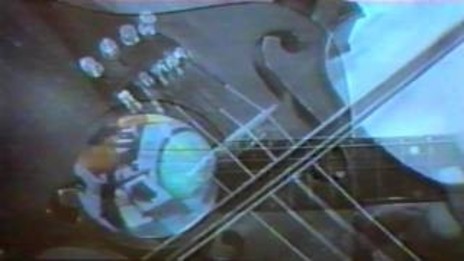AudioCulture
The noisy library of New Zealand music
Te pātaka korihi o ngā puoro o Aotearoa
Drone
No matter. The solitary airing proved more than enough. For those listening outside the main population areas the track being highlighted, ‘A Collision’, was a revelation. Here finally was proof that the New Zealand post-punk resurgence was bearing fruit in the nation’s smaller centres.
The political, Cure-ish single Rome released on the band’s Adespoton Productions label was as sparse and elusive as the group itself. Media coverage of the new record was mainly limited to print reviews.
Too art-minded for the pubs, too rock for the galleries, intimidated by neither, Drone played out often as a trio and the augmented DRONEnsemble.
With higher education beckoning that brief flicker of independent spirit could easily have remained just that as life swept the group into its predictable grip. But what began in a school classroom in an east coast city on the North Island of New Zealand in the early 1980s picked up a peculiar momentum that didn’t stop until January 2000 when Drone performed one last time in a former London school in Greenwich.
As Drone, Rome’s core members Daniel Newnham (bass, cello, vocals) and Darryl Hocking (guitar, vocals) added percussionist Gareth Farr and Rosemary Whitehead (violin, keyboards, vocals) and proceeded to carve out their own distinctive sonic and visual space in the Auckland and New Zealand indie scene of the 1980s and 1990s.
Too art-minded for the pubs, too rock for the galleries, intimidated by neither, Drone played out often as a trio and the augmented DRONEnsemble and left behind an individual body of recordings that is one of the unacknowledged precursors of a sound now more likely to be fostered by the Audio Foundation.
A Collision
Looking back on those formative days from his Paeroa home in June 2015, Rome co-founder Daniel Newnham remembers punk and its immediate aftermath barely registering in the small sunny seaside city of Tauranga in the late 1970s and early 1980s.
“We didn’t have student radio, not being in a big city. It was just through watching stuff on Radio With Pictures and getting NME because NME was a really good source of information not just on music, but movies and literature. And you could post away overseas for records that would turn up eventually. They didn’t cost that much.”
The local pickings weren’t entirely bare either, says Darryl Hocking, the other half of the original Rome duo. “A lot of left of centre records, like The Fall, were available quite easily. I got a Fall Grotesque from Farmers. I bought it from one of those stands.”
New Zealand-released post-punk records could also be found in record shops like the one in Wharf Street, Luigi’s second hand outlet in Greerton and the inner city EMI Records.
Live it was mostly blues and covers groups and touring band tour shows including Split Enz at the soundshell and Street Talk and Mi-Sex at the town hall. Summer tours at Mount Maunganui were annual events although the music was more straight rock.
Out on a limb playing parties and halls was Tauranga Boys High punk band, The Officials, who in 1981 counted in their ranks Hocking, Newnham, Graham Hardaker (guitar) and Stephen Neil (drums), who was later replaced by Todd Dance. Basic punk songs, they were written mostly by Darryl Hocking. A few covers made up the rest of the set. Like-minded groups were few in the Bay City.
Daniel Newnham: “There was a guy called Bill in a band called Various Artists that we supported. They’d been playing Velvet Underground covers. They had a guy, Dominic on guitar. He had a crazy wah pedal, so you had a kind of like an indie soul Velvet Underground cover then there’d be a three-minute bluesy rock solo. We played with them out at Omokoroa Hall. Nobody turned up.”
That was all right but Hocking and Newnham soon turned their minds to creating music more in line with the challenging post-punk sounds they were now listening: Joy Division, The Cure, The Fall.
Darryl Hocking: “Those guys [in The Officials] were less interested in pushing the boundaries. We’d [Hocking and Newnham] both studied art – and were influenced by different art movements of the 20th Century and the Modernist way in which they pushed boundaries and experimented – and became interested later in Fluxus movements and some of the Dada-esque sort of stuff.”
The restless pair brought Rome to life in early 1982 and they were soon recording original songs. Daniel Newnham: “The high school had a tape recorder, which was crucial – a Revox B77. We thought, ‘neat, we’ll write songs and actually record them.’ I was in the seventh form and you were meant to be reasonably responsible and I got to take the machine home.
“We had no desire to play live as there would not have been much of an audience for our music in Tauranga. There wasn’t really anything there that we related to. Nationally it was stuff from Flying Nun Records and other local labels and anything cool seen on Radio With Pictures or read about in RipItUp.”
There was to be one live outing. Already aware of the musically adventurous Terrace Scene in Wellington, the Tauranga duo contacted the promoter of key group Beat Rhythm Fashion in the capital. Newnham and Hocking met up with the friendly trio on a trip south. After performing in the band’s living room, Rome and their five-song set were added to BRF’s bill at Taita Hotel on 20, 21 and 22 May 1982. The live ads listed Rome simply as a “Tauranga band”.
Colliding Circles
In the early 1980s post-punk New Zealand was a set of smallish irregularly connected communities slowly knitting themselves together through national conduits such as RipItUp, In Touch, Barry Jenkin’s radical late night radio show, records, tours, personal contact and informed chance.
The post-punk movement had already produced a recognised and musically diverse reaction in Auckland, Wellington, Christchurch and Dunedin. Now it was the turn of the smaller centres. Whangarei spun off a new punk scene and a number of indie musicians who would become prominent in Auckland and Dunedin. Hamilton had The Accessories and Palmerston North had Skeptics.
The New Plymouth scene centered on Nocturnal Projections and Brian Wafer’s Ima Hitt Records, which had an active mail order evidenced by a series of small black-boxed ads in RipItUp and an occasional newsletter. One of those ads offered up Rome’s ‘A Collision’, the tune already played on Jenkin’s radio show.
Daniel Newnham: “By the time we came to do the single [in late 1982] our friend Paul Batten had joined on drums. We realised he had great natural rhythm and would be of the right mind to fit our creative bent. At this point we all wrote songs.
“The words for ‘A Collision’ came from the newspaper. I was into collage/ cut up and kept headlines from the whole Poland saga around the Solidarity trade union movement. I think they were simply vocalised in time-order of events. Darryl sings this.”
“For ‘Authoritarian Mother’ the title was grabbed by a random page turn of an art book from the name of a de Chirico painting. The words are Dadaist – Dada itself feels nothing, it is nothing ... etc. This really appealed to me as a statement. The vocal is mine.
“ ‘Jasna Gora’ [the second song on the B-side] is the name of a mountain in Poland near where Pope John Paul II was from. The words are also from the newspaper. The vocal is by Paul. He was very into literature and a very bright guy doing English, French, Spanish, German and Japanese in seventh form.”
Rome recorded the three-song single at The Lab Recording Studio in Auckland with Bill Latimer, who met the group while staying at Darryl Hocking’s parents’ motel in Greerton. Latimer encouraged the pair to come up and do some studio recording.
Daniel Newnham: “We drove to Auckland on a Saturday. We started recording about 4pm, stopped at midnight, slept in the studio and finished it on Sunday. Then we drove back to Tauranga. I don’t remember if there was much mastering. We left the rest of the process to the white coats at EMI in Wellington.”
Darryl Hocking: “You could get it pressed quite easily there. For the Rome single, we got a hundred copies pressed and it probably cost a hundred dollars. They made a mistake and put the labels on the wrong side and we managed to get another hundred done for free. All we did was put stickers on the incorrect labels. We sold them released in a brown paper bag with a drawing of the Japanese sign for Rome.”
The individually numbered records came packaged in the plain brown sleeve with a lyric sheet for ‘A Collision’. The label name given was Adespoton Productions. Adespoton is the Latin word for anonymous.
Paul Batten and Daniel Newnham took to the road and personally placed the single in record shops around the North Island.
To make the record available to the wider public, Paul Batten and Daniel Newnham took to the road and personally placed the single in record shops around the North Island. Brian Wafer’s Ima Hitt in New Plymouth took 50 copies. Outside Jenkin’s lonely spin, the Rome single only had limited airplay on the one progressive local radio show beaming out of Tauranga.
Daniel Newnham: “There was a great DJ on Radio BOP [Bay of Plenty], Brent Clough, who did a Sunday afternoon show called Sound System. He played post-punk. I don’t know how he got this slot because it was very unusual for Radio BOP. He was well up to date and current. NME savvy.”
There was one final Rome release before Newnham departed for Ilam art school at University of Canterbury in Christchurch in early 1983. The Colliding Circles tape coupled the single’s three tracks with five others that were recorded on the high school’s trusty 2-track. Newnham had a variety of recording devices by then.
Daniel Newnham: “I bought one in Wellington during the BRF trip. I bought a flat bed reel to reel. One song on the Rome tape has got a tape loop on it, the buzzing noise of Darryl’s amplifier recorded at 15ips (inches per second) and then chopped down to 1-7/8ips.
“For another of the songs, I sat and taped a movie. It was an obscure European movie in Polish. There were two TV channels then. Quite often there was a good film [on the second channel] and I’d just sit there with a cassette deck and hit record at what seemed like an interesting part of the film and tape it. That created a really messed up précis of the movie and we’d just put that on and play over it.
“We were trying to play around with all those different ideas. That was part of the fun. It was also a reaction to the more formal music that we were doing in the band before that.”
Land of the Free
With Paul Batten at the University of Auckland in 1983, Daniel Newnham at Ilam in Christchurch and Darryl Hocking still in the seventh form in Tauranga, Rome disbanded.
Daniel Newnham formed A Fragile Line in the southern city with David Jamieson and Jeff Harris, who was replaced by Caroline Gordon. The New Order influenced group made it as far south as Dunedin for Empire Tavern shows with The Rip.
Next up for Newnham in 1984 was Crane who included ‘Chorale’ on the Biding Our Time compilation tape two years later.
In 1986 Newnham moved north to Elam Art School at University of Auckland where he reunited with Darryl Hocking, who was also studying there. They added fellow former Tauranga citizen Rosemary Whitehead to form Drone with percussionist Gareth Farr. The new quartet wasn’t long in gestation and soon stepped out at Auckland’s Performance Café on 22 July 1986.
After a Windsor Castle date on 11 September with Insect, the two groups took to the road for several nights at New Plymouth’s White Hart in mid-September and an show at Hamilton’s Hillcrest on 2 October. The Cascade Bar at Auckland’s Royal International in the inner city hosted Drone on 6 November.
There was a single that year, ‘Land of The Free b/w ‘The Farmer’s Song’, which provided two distinct pieces of the group’s sonic puzzle.
Darryl Hocking: “As we moved into Drone, we moved away from more conventional lyrics.”
Daniel Newnham: “And that probably came from literature – Burroughs and other sources.”
Darryl Hocking: “The Farmer’s Song’ is literally a newspaper ad – Do You Want To Be A Farmer?”
Rosemary Whitehead: “We used to get some off boxes – we’d read the back of boxes and that would be our lyric.”
Captured and remixed by Drone at bFM and engineered by Alistair McDiarmid, ‘Land of The Free b/w ‘The Farmer’s Song’ was independently released and received good airplay on the Auckland student station.
DRONEnsemble
Drone’s first show of 1987 moved them out of the pubs and cafes into the rarefied air of contemporary gallery Artspace on 19 June. With Hocking and Newnham enrolled at the Elam Intermedia department run by From Scratch stalwart Phil Dadson, and now minus Gareth Farr, Drone’s musical outings that year would increasingly be in less traditional inner city environments.
A return to Tauranga on 3 and 4 July found them at the St Amand by the waterfront. Drone ended the month at the Elam Ball, which gained brief notoriety when NZ Truth published a report headlined, “Orgy of the Year: Sex on Show and Drugs Galore at Student Bash”.
Drone saw July out and August in at City Hotel with Nat Curnow. Artspace hosted the group again on 23 September and 4 and 5 October, either side of a return Hillcrest Tavern slot. But it was the trio of extended early week DRONEnsemble performances with Laurence “Yoh” Landwer-Johan (The Screaming Meemees), Michael Ghent, Martin Kean (Blue Meanies, The Chills) and James McCarthy, staged at Freemans Bay Community Centre over 26-28 October 1987, that really got the critics going.
Graham Reid’s review from 27 October 1987 set the scene. “Simply entering the room and confronting the equipment used by the six piece performance group, the DRONEnsemble conjures up myriad possibilities. Oil drums, steel slabs, handmade microphones with wires attached, television sets and conventional guitars and keyboards make for a formidable armoury.”
NZ Listener’s classical music columnist William Dart was in the audience as well and wrote up one 90-minute performance as Scratching At The Gate. “The DRONEnsemble’s performance area was dominated by their giant gate and pole sculptures,” he noted. “These consisted of amplifying horns at the end of a stretched piano wire mounted on either a swinging gate structure or simple poles. Contrasting with these was a set of three kotos fashioned from 44 gallon drums also using piano wires for strings.”
The core trio of Daniel Newnham, Darryl Hocking and Rosemary Whitehead, dressed in white overalls highlighted by round white lights, moved from there to concentrate on electric guitar, bass and digital cello.
Dart singled out ‘Gay Gordons’ as a piece that “commented on the resilience of the English spirit and included a lengthy quotation from the inscription on Scott’s statue in Christchurch” and compared the group to From Scratch.
“In the middle of the performance, a short video showed the musicians playing pole sculptures in various Auckland locations from Whatipu and Karekare and [the] city reservoir,” he added.
Indicating the two creative worlds that Drone was straddling, RipItUp chipped in a typically literate and insightful assessment from Jewel Sanyo. “Industrial lullabies from the Dr Seuss school of music. Oil drum barbeques turned upside down and wired up kotos, giant megaphones welded to arcs and poles, a dustbin lid and the old school bell all feature in the Drone installation. Six operators in white overalls manipulated the sculptures/ instruments with druidic solemnity.”
Two days on, the three-piece Drone was in Wellington at Clyde Quay School preparing for Jack Body’s Sonic Circus. The group’s 31 October performance at the Wellington Town Hall Concert Chamber drew favourable comment from the respected contemporary classical composer. “Drone aroused a tremendous amount of enthusiasm and interest,” he told the group in a letter dated 11 November 1987.
Music for Guitars and Piano
Standing on the side of the road near Kaikoura in the midst of a national tour in late 1988, Drone had two things on their mind. How to repair the twisted trailer now pushed safely to the highway’s edge and how to get to a TV set to see Radio With Pictures play the ‘Moonsong’ video which featured a track from the newly recorded but still unreleased Drone mini-album.
Temporarily abandoning the trailer and their gear, the group opted for the rare thrill of national TV exposure. By then, Drone were well into the most comprehensive New Zealand tour they would undertake. The trio set out in early November 1988 with soundman Ron Young for a long sweep of pubs, with the occasional art gallery and hall thrown in that ran well into mid-December.
Finally free of study, Drone kicked off 1988 with a 30 January performance in Auckland on the ferry Toroa, before lining up with The Verlaines and Sneaky Feelings (amongst others) at the Galaxy on 7 February for a show set up to help reimburse groups out of pocket from the cancelled Neon Picnic music festival.
They returned to Artspace in late February 1988 and weekend stands followed: the Rising Sun on Karangahape Road in March with Teeth, August with Indigo Underground and October with Headless Chickens.
Reviewing the second of the October shows for RipItUp, Greg Johnson thought Drone were, “a trio with an approach to things musical that would fit more comfortably alongside the NZSO than your average pop band.”
“Drone took the stage in front of a strangely subdued, but ever growing crowd on this particular Saturday night. After a disturbing period where it looked as if they weren’t getting it together at all, they came to a piece called ‘Music For Guitars and Piano’. Ah, now the band locked together and in the space of one (excellent song) the audience is captured hook, line and seriously worn leather jacket.
“Drone are best when they are driving drums and guitars. Dare I say, they have overtones of Cocteau Twins in places. I couldn’t help thinking there must be a better environment for a band like Drone to be playing in away from the expectations of ‘the pub’ – a theatre perhaps. Meanwhile we patiently await their forthcoming album.”
Ahead of a national tour that would take them to both pubs and galleries, Drone found time to sit down with Clare Pasley for an article published in November’s Bifim, wryly headlined “Great Trailer Journeys of New Zealand”.
Darryl Hocking explained to Pasley that having a foot in both the popular and classical camps challenged audiences and that was a good thing. It was the music and use of guitar, bass, violin, cello, keyboards, vocals and found objects that dictated the trio’s approach.
“The variety of instruments keep us and the audience interested although it messes with the flow. We’re interested in rhythm. Rock rhythms are always on the downbeat, but ours aren’t. We want to be accessible, but at the same time, push ideas like breaking up rhythm,” he said.
Words were used sparingly. “There always has to be some reason why they’re there,” Hocking explained, pointing to the recently recorded ‘Music For Guitars and Piano’ that had only seven.
“I wanted to make some kind of chain with words. You have one word, then have it again, but then you have it relating to another so they link into each other and come back to the start,” Daniel Newnham added.
“We work that idea quite a lot, circular motion, cycles. That was a phase we were going through, but we are trying to move away from that now by writing things that never repeat. It’s a challenge. We are always trying to do something different.”
With that the trio packed their PA onto their home made trailer in early November and hit the road. After two nights at New Plymouth’s Ngamotu, Drone headed inland to The Superliquorman in Palmerston North where they linked up with The Wart from Wellington.
They lingered in the Manawatu city long enough for an extra show at The Stomach before journeying to New Zealand’s capital where they stepped out at The Clarendon on different nights with The Wart and Jean Paul Sartre Experience for performances that were reviewed favourably in the Evening Post.
The Suter Gallery in Nelson was next, before Drone tracked deeper south to Oliver’s Restaurant in Central Otago. Two nights at Dunedin’s Empire Tavern on 25 and 26 November followed then it was North to the Brydon in Oamaru, Terminus in Timaru and Subway in Christchurch.
Crossing the Cook Strait to Wellington, Drone managed a night at Brooker Gallery. Four days later they were at The Backbar in Hastings.
Closer to home, the trio had a woolly night high on the Coromandel Peninsula at Colville before dropping back down to ground zero Tauranga for a return weekend at the St Amand. Twisted trailers aside, the trek had been a success and live reviews were generally positive.
Fans hungry for new recordings that year had to be appeased by a track on Mark Webster’s Walking Monk compilation AD1987. Webster, who flatted with Hocking and Whitehead, also plucked the Rome single’s B-sides for The Old Tape collection.
Drone’s seven-song mini album was recorded and produced by the band with a $1,000 grant at Muriwai that year and mixed at bFM in 20 to 30 hours by Drone and Matthew Heine. Mastered at Mandrill and pressed in Australia, the new record didn’t arrive until April 1989. Featuring songs well tested in performance, NZ Listener’s review used words like “sparse” and “haunting” to describe the record’s feel and depth of sound. Strong reviews were won in RipItUp and NZ Herald.
Outcrop
In late July 1989 Drone was packing yet another unusual piece of sound equipment into the station wagon and trailer. The Spinner was a three metre high, six metre wide rotating three-armed speaker system that circulated the band’s sound not unlike a giant Leslie speaker. It was effectively a highly visible piece of kinetic sound sculpture.
Drone had The Spinner on stage with them at Sound/ Watch at Artspace on 2 and 3 July and early the following month at Outcrop at the Govett-Brewster Gallery in New Plymouth, where it was augmented by video.
1989 had started quietly for the group with a night at Auckland’s Albion in early April. In early June, the trio were back on the road for a main centre tour that took in Palmerston North’s Superliquorman ahead of two dates at Wellington’s Clarendon with Clapometer, the drum machine backed duo featuring The Alpaca Brothers’ Nick Wilkinson on bass and guitar.
With Hocking and Newnham practising every day, the album came to life on an 8-track in a Grey Lynn shed.
There were two return performances at Christchurch’s Subway before Drone linked again with Clapometer at The Burgundy Bar in Dunedin’s European Hotel. A third show with the Wellington-based duo at The Venue in Auckland’s Station Hotel in early November was chased by a benefit show for Stamp magazine on a bill with Chris Knox and Jonestown Olympics on 9 December at City Hotel.
Bunkered down in their Grey Lynn practice room in 1990, Drone spent a good part of the year recording The Fat Controller album, a record they later said captured everything they were about. With Hocking and Newnham practising every day, the album came to life on an 8-track in a Grey Lynn shed and was mixed at the Aotea Centre, Auckland.
Five more performances that year utilised The Spinner, all at Wellington City Art Gallery between 30 March and 1 April 1990. Three packed out shows in Christchurch Arts Centre’s Great Hall on 30 January and 2 February 1991 and one final Spinner-less show at The Gluepot on 22 February with Blue Marbles and Queen Meanie Puss were the last that Drone played in New Zealand
Having witnessed the group’s NZ finale, reviewer Mark Amery, banging an already old drum, talked about the trio’s contrast with popular sounds – “Live music doesn’t have to feel like a dirty smelly flat,” he said, suggesting that “churches and deserted beaches” be included in their “choice of performance space”. Too late, Drone had already decided to move offshore to London via America and Europe.
The Fat Controller
The early 1990s diaspora of New Zealand post-punk talent was already widespread as Drone organised a string of shows in America using Phil Dadson’s contacts, starting with two well-attended performances at San Francisco’s New Langton Arts Gallery.
Having packed The Spinner away for now in New Zealand, Drone sent ahead a video of the three-armed machine and took a Tascam tape of the sound it made with them.
While many of the planned Drone shows in America didn’t pan out, the trio of Newnham, Hocking and Whitehead still enjoyed journeying by car across the continent. Soundman Michael Ghent was to meet them in Europe. Second soundman Michael Hodgson opted out completely. Unable to sell their vehicle in New York, Drone gifted it to Bailterspace’s Alister Parker.
On 5 July 1991, Drone set up their gear in Eindhoven in Holland for a performance at Het Apollohuis, a three storey concrete-floored venue in an old cigar factory. Taped by for broadcast by Dutch national radio, the show earned the group a welcome 750 guilders on top of their live fee of the same amount.
Rene van Peer was there and reviewed the happening for Eindhoven’s Dagblad. “In their performances in New Zealand they use a sound-sculpture: loud speakers mounted on a revolving triple rotor,” he wrote. “As transport of this construction was not possible Drone recreated its whirling effect by having sounds on tape move along speakers set up in a triangle around the audience.”
“Drone’s compositions lie intriguingly on a sultry and jagged intersection of chamber-music, minimal music and rock. Rock influences were apparent in Hocking’s hacking piano style and Newnham’s and Whitehead’s vigorous bowing – it gave the music an uncommon intensity and drive.
“The tape – containing voices, percussive sounds and fragments of their own music, in varying degrees of distortion – acted as an ominous drone. Over this groundwork the musicians weaved their interlocking melodic and rhythmic lines, on which they overlaid their singing. The band condensed the thrilling atmosphere of their music with heavy, harrowing chords, screeching and roaring tones and ever-repeating patterns on the tapes. The latter provided a basis for each composition and linked them together in one uninterrupted chain.”
Turn + Twist
1992 found Drone ensconced in London and finding their feet as a live act in the new metropolis. CoolTan Arts Co-Op in Brixton hosted them in February, but it would be August before Drone managed a consistent run of shows. A night at Halfmoon in Herne Hill on the 14th was followed three days later by the first of many nights at The Falcon in Camden.
Come October and Drone could be seen and heard onstage at Club Dog at the George Robey in Finsbury Park, the Falcon in Camden and St George’s Church in Bloomsbury. A night with The Bats (who Drone had stayed with in Christchurch) at Underworld in Camden demonstrated the long reach of New Zealand’s post-punk music. A final 17 November date at Kentish Town’s Bull & Gate ended the year.
Jed Town, yet another London-based New Zealander (of The Features and Fetus Productions) helped Drone find an outlet for the still unreleased The Fat Controller album. German label Normal Records, who had great success releasing Flying Nun Records acts in Europe, put their hand up for a CD release of the six-song album on QDK Media in 1993.
Reviews were again favourable as they would be for the band’s self-released 1993 single ‘Cavern’ b/w ‘Stravinsky’ engineered by Jed Town and mixed by Drone and Town in Hackney.
“‘Cavern’ has a classical piano/ strings sound, overlaid with haunting choral voices – an eerie, unsettling noise, while ‘Stravinsky’ has a similar vibe,” fanzine Earzone noted in Autumn 1993.
Live notices were equally complimentary. The trio’s outing at Camden’s Falcon on 23 July drew this response: “New Zealand three-piece Drone surpassed all definitions with an incredible but short display of ambient guitar, backed by keyboards.” It was Drone’s second Falcon show in a year that saw them at Vox in Brixton in September and Noisepaint in Vauxhall, Sate at Brixton and Bass Clef in Hoxton in October.
But that was it for three years. ‘Turn + Twist’ backed with ‘Blow x Blow’ didn’t arrive until 1996 on i/ Che Records, who then put the group in contact with Peter Morgan at Freek Records. A CD release of Drone’s self-titled album with six untitled tracks resulted in 1996.
Psychedelic fanzine Ptolemaic Terrascope No 22 said this of the LP: “The sparse atmospheric tension of a Dadamah [a Christchurch band] are fused with minimalist orchestral ambience and a childlike hushed vocal sound culled from Stereolab to create a multicoloured stereophonic palette.”
In January 1997, Melody Maker interviewed the trio. “Travel and forward motion are constants in our music. Music is all about movement. It should pick you up in one place, carry you along with it and then dump you somewhere totally different. Avoiding the repeated two-minute chunk structure makes it easier to do that,” an unidentified member told journalist Mark Luffman. “When people hear that we use improvisation, they seem to expect jazz. But we’re the opposite, we try not to let anything stand out.”
There would be two final DRONEnsemble performances on 22 and 23 January 2000, at Catherine Grove Studios in Greenwich. Darryl Hocking had retrieved The Spinner from New Zealand, cut it up, shipped it over and reassembled it for the event. But that was it. Rosemary Whitehead and Darryl Hocking had two small children to raise and New Zealand looked a better bet. A planned New Zealand tour for 2000 didn’t pan out after their funding application was unsuccessful. While Drone haven’t played since, they have never officially split.
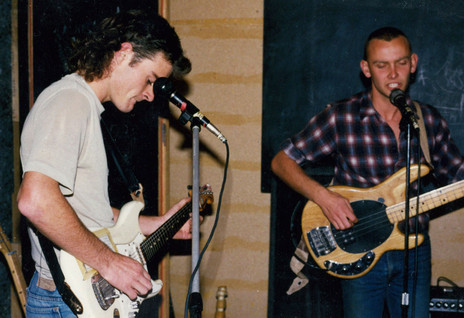
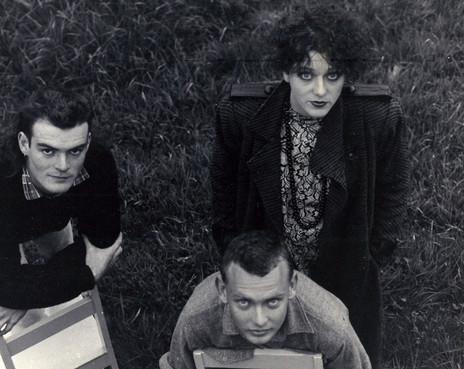
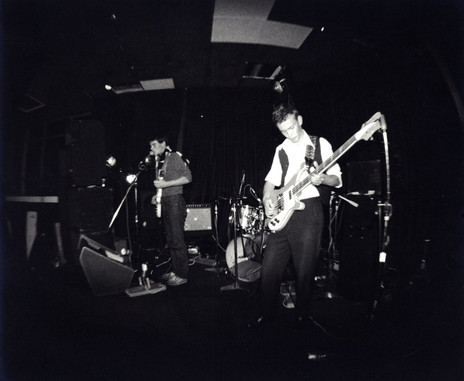
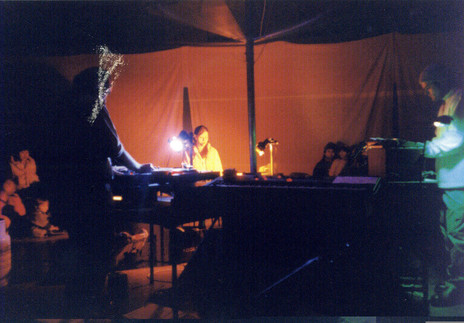
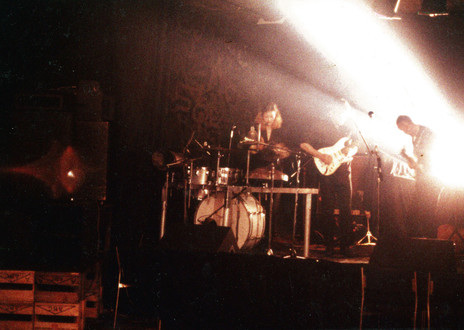
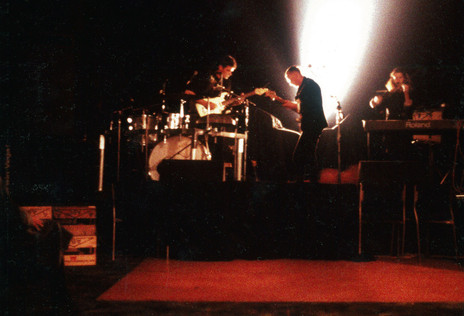
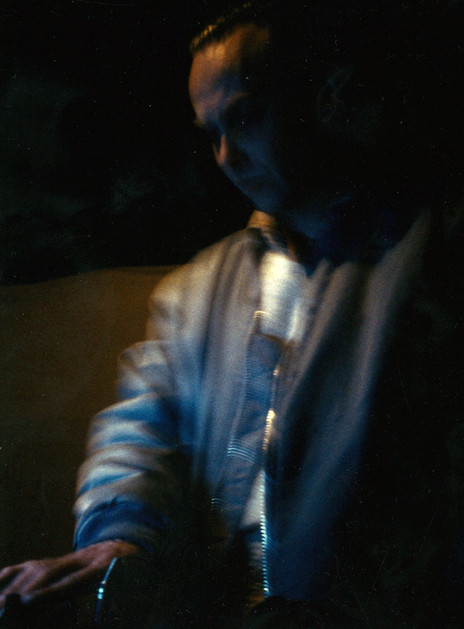
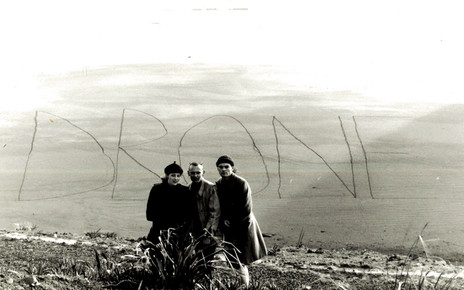
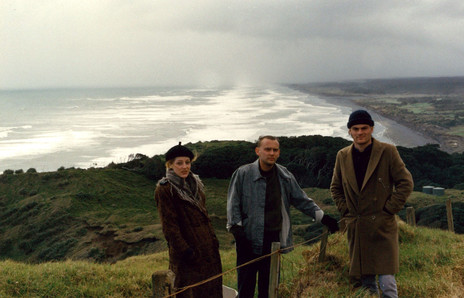
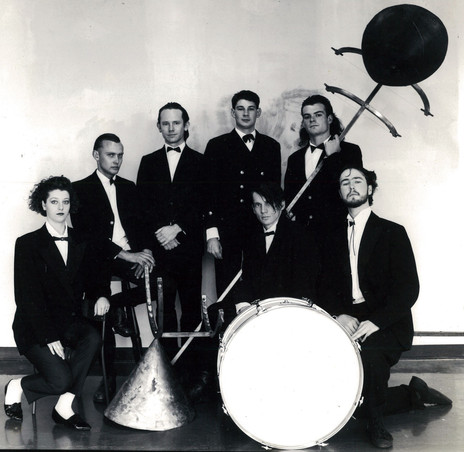
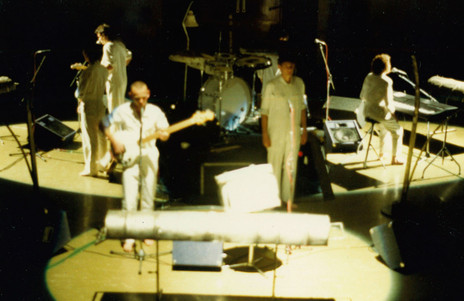
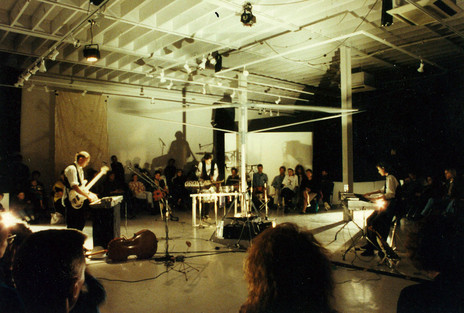
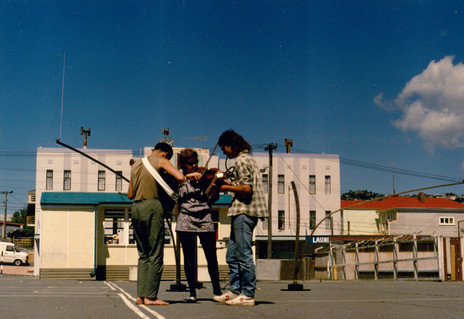
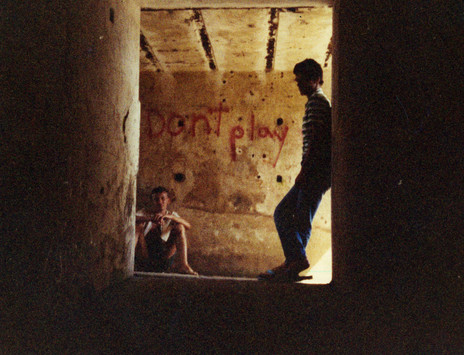
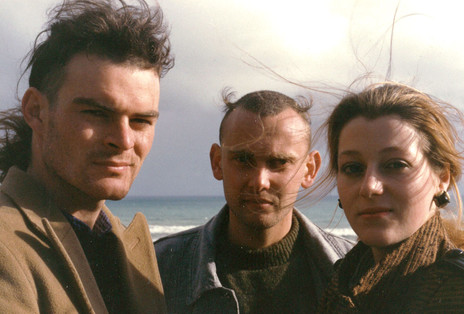
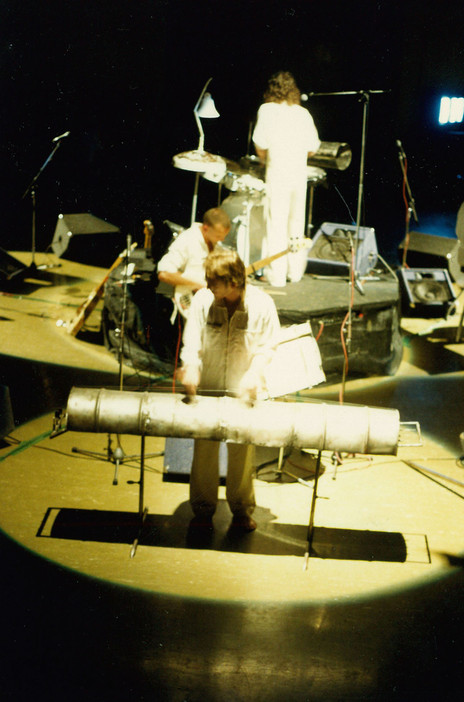
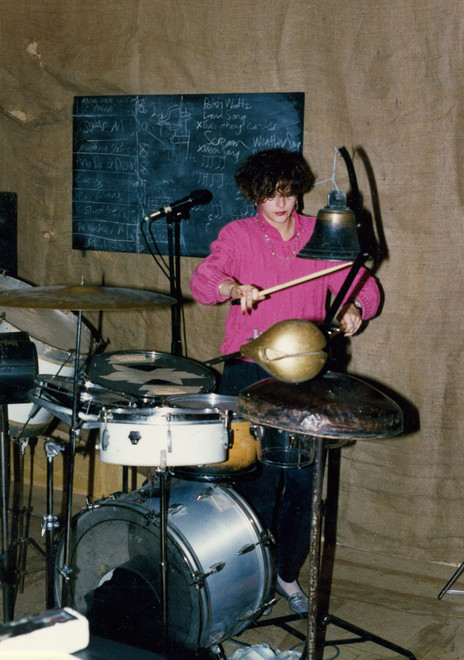
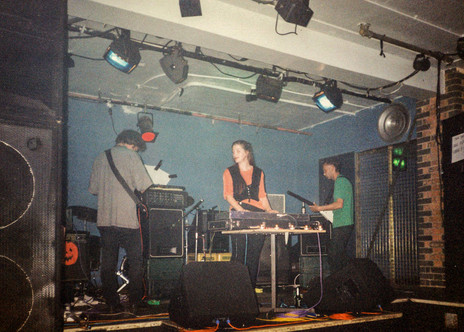
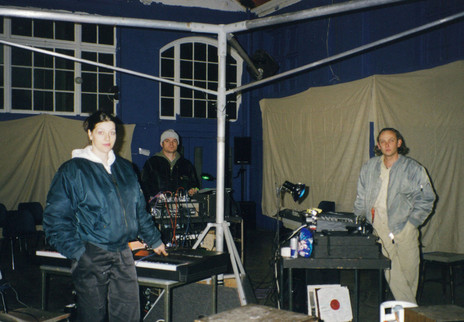
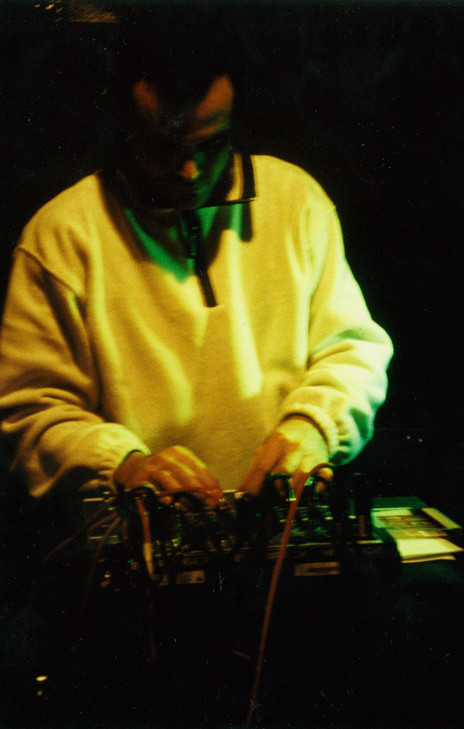
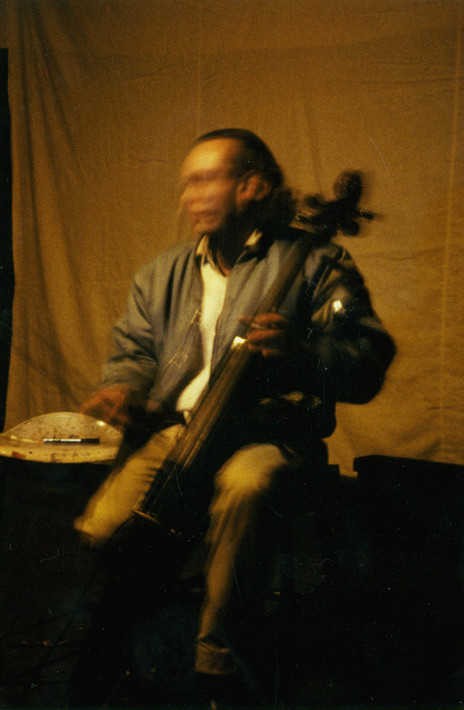
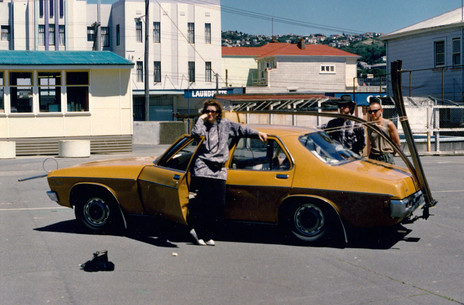
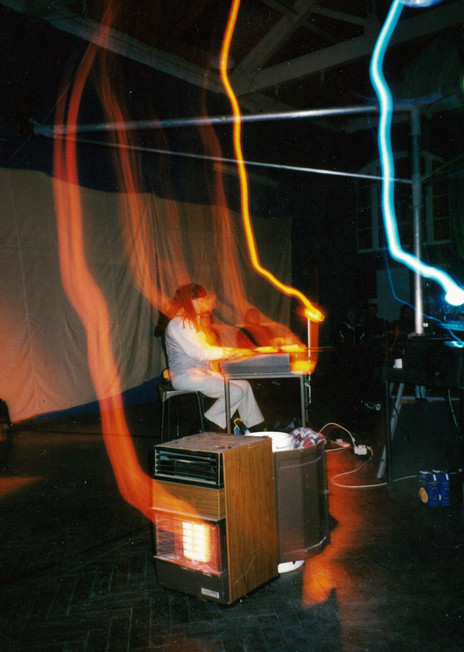
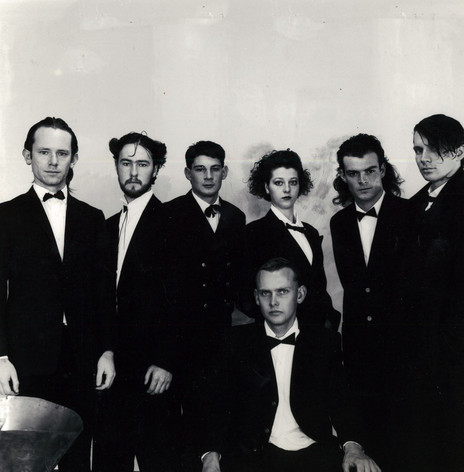
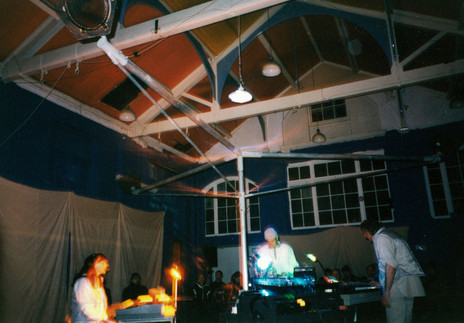
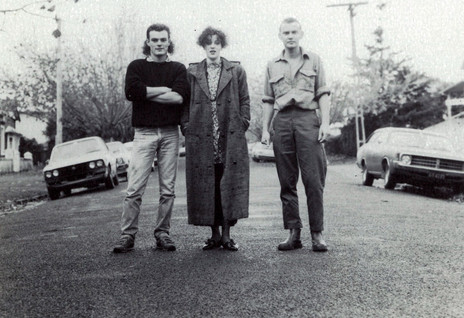
DDR
Q.D.K. Media
Freek
Adespoton Productions
Daniel Newnham - bass, cello, vocals
Darryl Hocking - guitar, vocals
Gareth Farr - percussion
Rosemary Whitehead - violin, keyboards, vocals
All three key Drone members still perform and record: Rosemary in The Grey Lynn Ukuladies; Darryl in Snake Salvador with Kevin Tutt; Daniel in TLC.
Visit our sister site
NZ On ScreenMade with funding from
NZ On Air